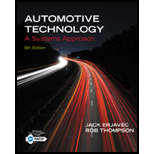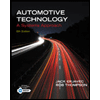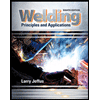
Automotive Technology: A Systems Approach (MindTap Course List)
6th Edition
ISBN: 9781133612315
Author: Jack Erjavec, Rob Thompson
Publisher: Cengage Learning
expand_more
expand_more
format_list_bulleted
Concept explainers
Textbook Question
Chapter 34, Problem 6ASRQ
When discussing the diagnosis of a positive back pressure EGR valve: Technician A says that with the engine running at idle speed, if a hand pump is used to supply vacuum to the EGR valve, the valve should open at 12 in. Hg of vacuum. Technician B says that with the engine not running, any vacuum supplied to the EGR valve should be bled off and the valve’s diaphragm should not move. Who is correct?
a. Technician A only
b. Technician B only
c. Both A and B
d. Neither A nor B
Expert Solution & Answer
Want to see the full answer?
Check out a sample textbook solution
Students have asked these similar questions
Which of the following is similar to a PCV valve but is specific to diesel engines?
PCM
EGR
AIR
CDR
What safety feature does the curcuit possess in addition to the pressure relief valve?
Technician A says throttle pressure is controlled directly by the pressure regulator valve. Technician B says one of the primary purposes of the pressure regulator valve is to fill the torque converter with fluid. Who is correct?
a.
A only
b.
B only
c.
Both A and B
d.
Neither A nor B
Chapter 34 Solutions
Automotive Technology: A Systems Approach (MindTap Course List)
Ch. 34 - A rich air-fuel ratio causes HC emissions to...Ch. 34 - What will result from too little EGR flow? And...Ch. 34 - What can result from a charcoal canister that is...Ch. 34 - What happens if a PCV valve is stuck in the open...Ch. 34 - Explain why the I/M 240 and similar tests are...Ch. 34 - How do you test the efficiency of a secondary AIR...Ch. 34 - True or False? No-start, surging, or stalling can...Ch. 34 - List five common causes for high HC emissions.Ch. 34 - Describe carbon monoxide (CO) emissions in...Ch. 34 - A restricted catalytic converter can cause all of...
Ch. 34 - Which of the following statements about EVAP...Ch. 34 - As a catalytic converter begins to deteriorate,...Ch. 34 - How much pressure does a typical EVAP pressure...Ch. 34 - Which of the following exhaust gases is typically...Ch. 34 - Prob. 15RQCh. 34 - While discussing the proper way to test a...Ch. 34 - Prob. 2ASRQCh. 34 - While discussing catalytic converter diagnosis:...Ch. 34 - While discussing EGR valve diagnosis: Technician A...Ch. 34 - While discussing EGR valve diagnosis: Technician A...Ch. 34 - When discussing the diagnosis of a positive back...Ch. 34 - While diagnosing a PCV problem: Technician A says...Ch. 34 - Technician A says that the AIR system should pump...Ch. 34 - While discussing PCV system diagnosis: Technician...Ch. 34 - While discussing EVAP testing: Technician A says...
Knowledge Booster
Learn more about
Need a deep-dive on the concept behind this application? Look no further. Learn more about this topic, mechanical-engineering and related others by exploring similar questions and additional content below.Similar questions
- True or False? No-start, surging, or stalling can be caused by an EGR valve that does not open.arrow_forwardTechnician A says an engine may use one or more valve springs per valve. Technician B says additional valve springs are used to control vibration and increase total pressure. Who is correct? a. Technician A b. Technician B c. Both A and B d. Neither A nor Barrow_forwardAn EGR valve that does not fully close can cause all of the following except ____ . a. a no-start b. stalling c. surging d. detonationarrow_forward
- Technician A says that the purpose of a valve body is to increase oil pressures in response to increases in engine speed. Technician B says that valve bodies are normally fitted with three different types of valves, which start, stop, or use movable parts to regulate and direct the flow of fluid throughout the transmission. Who is correct? a. Technician A only b. Technician B only c. Both A and B d. Neither A nor Barrow_forwardWhat is the difference between a reverse flow valve and a flashback arrestor?arrow_forwardWhile discussing the results of an oil pressure test: Technician A says that when the fluid pressures are high, internal leaks, a clogged filter, low oil pump out put, or a faulty pressure regulator valve are indicated. Technician B says that if the fluid pressure increased at the wrong time, an internal leak at the servo or clutch seal is indicated. Who is correct? a. Technician A only b. Technician B only c. Both A and B d. Neither A nor Barrow_forward
- When the engine is idling, the pressure regulator in a PFI system provides ____fuel pressure compared to the fuel pressure at wide-open throttle.arrow_forwardTechnician A says that if the PCV valve or connecting hoses become clogged, excessive pressure will develop in the crankcase and can cause oil leaks. Technician B says that if the PCV valve or connecting hoses become clogged, oil may be pushed into the air cleaner or cause it to be drawn into the intake manifold. Who is correct? Technician A Technician B Both A and B Neither A nor Barrow_forwardWhile discussing EGR valve diagnosis: Technician A says that if the EGR valve does not open, the engine may hesitate on acceleration. Technician B says that if the EGR valve does not open, the engine may detonate on acceleration. Who is correct? a. Technician A only b. Technician B only c. Both A and B d. Neither A nor Barrow_forward
arrow_back_ios
SEE MORE QUESTIONS
arrow_forward_ios
Recommended textbooks for you
 Automotive Technology: A Systems Approach (MindTa...Mechanical EngineeringISBN:9781133612315Author:Jack Erjavec, Rob ThompsonPublisher:Cengage Learning
Automotive Technology: A Systems Approach (MindTa...Mechanical EngineeringISBN:9781133612315Author:Jack Erjavec, Rob ThompsonPublisher:Cengage Learning Automotive TechnologyMechanical EngineeringISBN:9781337794213Author:ERJAVEC, Jack.Publisher:Cengage,
Automotive TechnologyMechanical EngineeringISBN:9781337794213Author:ERJAVEC, Jack.Publisher:Cengage, Refrigeration and Air Conditioning Technology (Mi...Mechanical EngineeringISBN:9781305578296Author:John Tomczyk, Eugene Silberstein, Bill Whitman, Bill JohnsonPublisher:Cengage Learning
Refrigeration and Air Conditioning Technology (Mi...Mechanical EngineeringISBN:9781305578296Author:John Tomczyk, Eugene Silberstein, Bill Whitman, Bill JohnsonPublisher:Cengage Learning Welding: Principles and Applications (MindTap Cou...Mechanical EngineeringISBN:9781305494695Author:Larry JeffusPublisher:Cengage Learning
Welding: Principles and Applications (MindTap Cou...Mechanical EngineeringISBN:9781305494695Author:Larry JeffusPublisher:Cengage Learning

Automotive Technology: A Systems Approach (MindTa...
Mechanical Engineering
ISBN:9781133612315
Author:Jack Erjavec, Rob Thompson
Publisher:Cengage Learning

Automotive Technology
Mechanical Engineering
ISBN:9781337794213
Author:ERJAVEC, Jack.
Publisher:Cengage,

Refrigeration and Air Conditioning Technology (Mi...
Mechanical Engineering
ISBN:9781305578296
Author:John Tomczyk, Eugene Silberstein, Bill Whitman, Bill Johnson
Publisher:Cengage Learning

Welding: Principles and Applications (MindTap Cou...
Mechanical Engineering
ISBN:9781305494695
Author:Larry Jeffus
Publisher:Cengage Learning
8.01x - Lect 27 - Fluid Mechanics, Hydrostatics, Pascal's Principle, Atmosph. Pressure; Author: Lectures by Walter Lewin. They will make you ♥ Physics.;https://www.youtube.com/watch?v=O_HQklhIlwQ;License: Standard YouTube License, CC-BY
Dynamics of Fluid Flow - Introduction; Author: Tutorials Point (India) Ltd.;https://www.youtube.com/watch?v=djx9jlkYAt4;License: Standard Youtube License